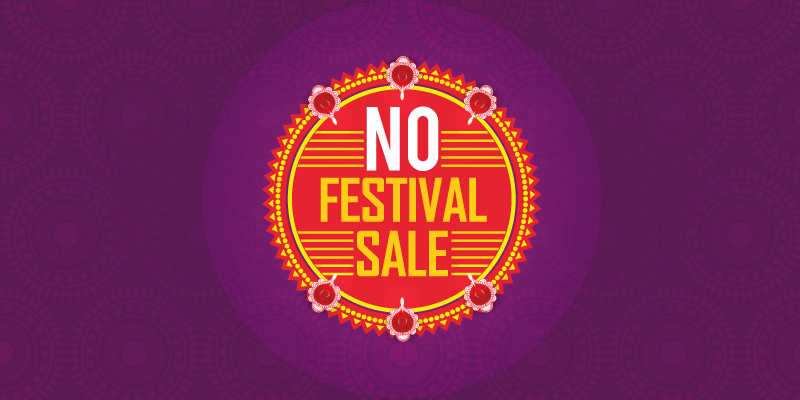From the e-commerce giants to Xiaomi and One Plus, how much of the explosive Diwali sales can you take
“I remember Diwali shopping being an event, a family outing, a one-off thing that happened with every single member of the family once in a year,” reminisces 35-year-old Gayatri. But today, the scene is very different. The world of e-commerce and online shopping has transformed the shopping behaviour of the consumer.
Shopping is no longer a novelty. You have season sales, midnight sales, flash sales, new launch sales, and, obviously, the flavour of the month – ‘Festive sales and the Big Billion Sales’. The period of October to December, which sees almost half of online retail’s annual GMV, is famous not just for lower prices, but also for wider selections.
And it isn’t just the biggies like Flipkart, Amazon, Snapdeal, Paytm and Shopclues anymore;smartphone brands like Xiaomi and OnePlus are also coming into the picture. This isn’t surprising.
According to Criteo’s survey, the Diwali period in the previous year saw an upsurge in average visitors on key Indian retailers’ websites, leading to an increase in the average sales of e-commerce companies. The biggest category during the sale was TV and mobile.

Is the ‘Sale’ sheen fading?
As a shopper, you are simply spoilt for choice. But is that all? How much is too much? For 23-year-old Seema, shopping online is no big shakes, and the Diwali or Dussehra festive season sale didn’t do much for her. She adds that the Diwali sale is one among the too many sales that she endures online, saying that this season, she might look to shop offline.
K.Vaitheeswaran, an internet pioneer, retail entrepreneur, adviser, mentor and speaker, says:
I think the sales this time have been quite underwhelming, in the sense that they haven’t been as attractive from a price point of view to customers as they were earlier. While everyone is claiming large numbers and big sales, I think the reality is that the sales this festive season have probably not changed too much over last festive season.
This is because the pricing this time is much closer to what you get in offline stores, and that is a deal breaker. People don’t shop online only for convenience, they shop online for the prices as well.
This year, only private labels are giving considerable discounts, as brands do not offer discounts below minimum operational price (MOP). This could possibly disappoint the customer, who might now prefer offline options.
This is despite the fact that marketplaces are allowed 100 percent FDI and are not allowed to influence pricing by sellers on their platform.
The game of GMV
But the festive seasons are the times when online stores are under big pressure to show GMV growth. Vaitheeswaran says:
When three to four sites are battling it out for supremacy, if they aren’t seeing significant sales regularly, then under the pressure to show decent GMV, they need to have sale after sale. But having more sales doesn’t solve the problem. If you want to show an increase in GMV over the earlier season, you need to get great prices back. But then the losses increase, and in this current funding environment, you need to show reduced costs and higher gross margins. And if you increase prices, sales go down; the cycle is never-ending and vicious.
However, according to RedSeer Consulting, a research and advisory firm, e-tailers are likely to surpass all sales expectations in the ongoing festive sale days and for the month of October 2016 as a whole.
Driven by this strong festive week performance, the industry GMV for the entire festive month of October 2016 is expected to be Rs 11,000-13,000 crore ($1.7-1.9 billion) and $20-23 billion in annualised run-rate terms. But the sale season is yet to end, and the cumulative results are yet to be seen.
A shift in focus
While the average metro city and urban consumer might feel jaded with the number of sales, one cannot deny the fact that Diwali is one of the biggest seasons for anyone looking for aspirational products. And this is true across both offline and online stores.
One interesting trend that has been seen this season is the shift in focus beyond the metros to customers from tier II and III cities.
ShopClues saw a 153 percent increase in mobile app downloads from tier III cities, while Snapdeal got a twentyfold increase in traffic from tier II and III cities. The North Eastern states were also active on both platforms.
According to CashKaro, about 40 percent of participation came from tier II cities, although metros and tier I cities continue to dominate. Amazon reported fivefold growth in customer acquisition, with 70 percent of new customers coming from tier II and tier III geographies. A statement from the company said that the sale saw a thirtyfold increase in orders from tier III cities.
Mohit Gulati, investor and Founder of Altius Ventures, says:
Looking at the way tier II and III cities are consuming, one can understand that the aspirational value of the Indian consumer is very high. Diwali is the time of the year when you buy things that you normally wouldn’t have bought. Flash sales are advantageous for people who have been waiting to buy something they have aspired for through the year. The spending on high ticket items like cars are on the wait-list this season.






